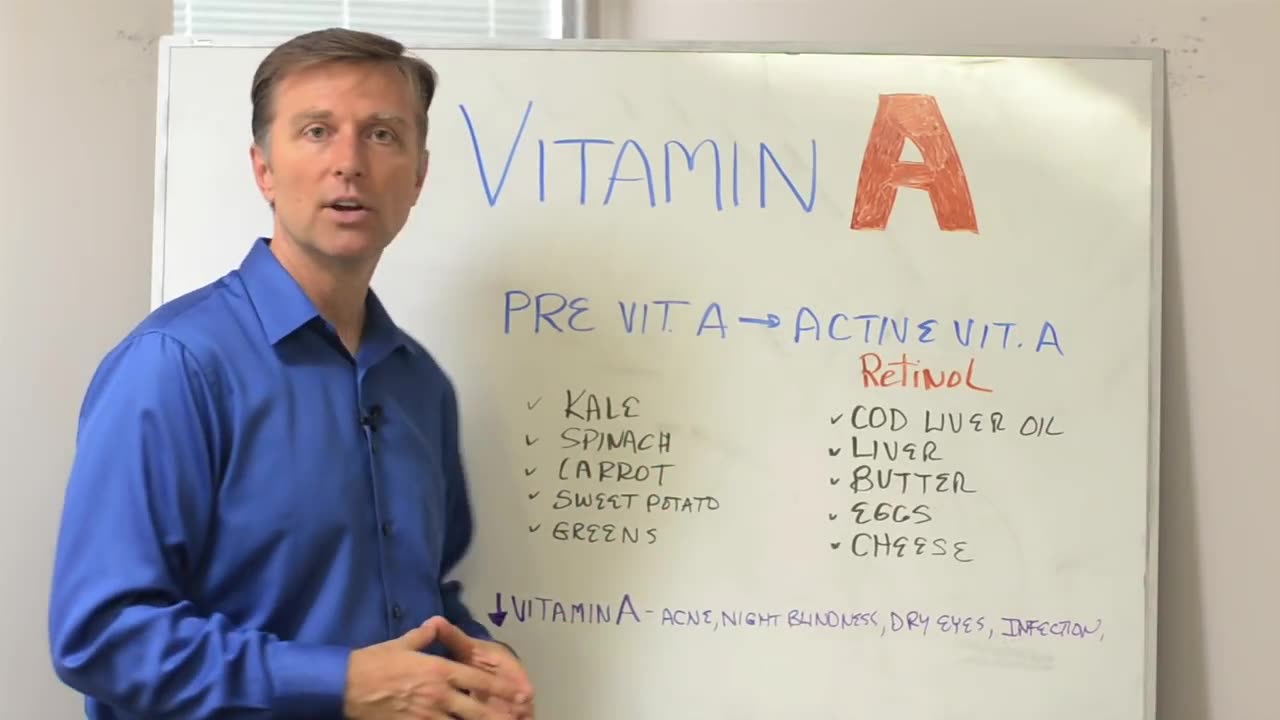Premium Only Content

Vitamin A: Sources, Functions, and Deficiencies
In this video, we’re going to cover vitamin A functions, sources, and vitamin A deficiencies.
Vitamin A is a fat-soluble vitamin. This means it has the ability to travel through fat, and it can be stored in fat longer. Fat-soluble vitamins can go right through a cell. Water-soluble vitamins can’t do this. Fat-soluble vitamins can affect the deep parts of the cell and DNA.
Vitamin A deficiencies can affect what your skin turns into at the genetic level. Symptoms of a vitamin A deficiency can include:
• Flaky skin
• White dots on the skin
• Dandruff
• Vision problems (night blindness)
• Infections
• Lack of lubrication of the eye or mouth
Great vitamin A sources:
• Cod liver oil
• Liver
• Butter
• Eggs (especially the yolk)
• Cheese
There are also foods that have previtamin A. This means it has to be converted into the active form a vitamin A. This conversion only takes place in certain parts of the body at certain percentages.
Sources of previtamin A:
• Kale
• Spinach
• Carrots
• Sweet potatoes
• Greens
What causes a vitamin A deficiency?
• Not consuming foods rich in the active form of vitamin A
• Not converting previtamin A to the active form (this has to do with a digestive issue)
• A lack of bile
• A congested liver
Dr. Eric Berg DC Bio:
Dr. Berg, age 57, is a chiropractor who specializes in Healthy Ketosis & Intermittent Fasting. He is the author of the best-selling book The Healthy Keto Plan, and is the Director of Dr. Berg Nutritionals. He no longer practices, but focuses on health education through social media.
-
 LIVE
LIVE
Side Scrollers Podcast
3 hours agoTwitch CONTROVERSY Hit New Low + Reddit Mods QUIT + FireMAN is Now Sexist + More | Side Scrollers
2,158 watching -
 10:18
10:18
Colion Noir
1 hour agoViral TikTok Proves Gun Owners Wrong?
3.42K6 -
 5:31
5:31
John Rich Official
12 days agoThe Righteous Hunter by John Rich
10.4K5 -
 LIVE
LIVE
Rebel News
1 hour agoEby threatens to block pipeline, Guilbeault out of cabinet, Land disputes continue | Rebel Roundup
379 watching -
 1:45:59
1:45:59
Robert Gouveia
3 hours agoAmerican Soldier DEAD! Trump Furious! Afghan 'Vetted by CIA'! Third World FREEZE!
33.3K19 -
 48:48
48:48
The Culture War with Tim Pool
2 hours agoThe West Is COLLAPSING Under Mass Migration | The Culture War's Across The Pond
18.4K39 -
 LIVE
LIVE
The Mel K Show
2 hours agoMORNINGS WITH MEL K - We Have Not Yet Begun to Fight - The Clock is Ticking! 11-28-25
1,018 watching -

Film Threat
14 hours agoHOLLYWOOD FOR SALE! BLACK FRIDAY BLOW OUT! | Film Threat Livecast
9.24K1 -
 LIVE
LIVE
The Shannon Joy Show
3 hours agoSJ Show Nov 28 - The SJ Friday Matinee Watch Party With Commentary Featuring The Big Short!
32 watching -
 35:39
35:39
Grant Stinchfield
5 hours agoThe Medical Deep State Exposed — And McCullough Has the Receipts!
9.43K